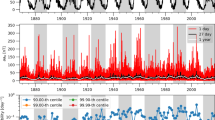Abstract
In their description of the solar radio emissions from the great sunspot of February 1946, Appleton and Hey1 pointed out that a number of sudden enhancements of intensity, observed at about 5 metres wave-length, occurred simultaneously with increases in D-layer ionization as indicated by fade-outs on long-distance radio-communication circuits. This increased ionization, which is believed to be due to enhanced solar ultra-violet radiations, strongly absorbs the radio communication waves (of the order of 20 metres wave-length) but does not produce any marked absorption of the solar radio emissions at wave-lengths of 5 metres or less.
Similar content being viewed by others
References
Appleton and Hey, Phil. Mag., 37, 73 (1946).
Jánsky, Proc. Inst. Rad. Eng., 20, 1920 (1932); 21, 1387 (1933); 23, 1158 (1935): 25, 1517 (1937).
Saha, Nature, 158, 599 (1946).
Martyn, Nature, 159, 26 (1947).
Author information
Authors and Affiliations
Rights and permissions
About this article
Cite this article
HEY, J., PARSONS, S. & PHILLIPS, J. Solar and Terrestrial Radio Disturbances. Nature 160, 371–372 (1947). https://doi.org/10.1038/160371a0
Issue Date:
DOI: https://doi.org/10.1038/160371a0
- Springer Nature Limited
This article is cited by
-
Frequency Variation of the Intensity of Cosmic Radio Noise
Nature (1948)
-
Der Einflu� der Erdatmosph�re bei astronomischen Beobachtungen
Die Naturwissenschaften (1948)





